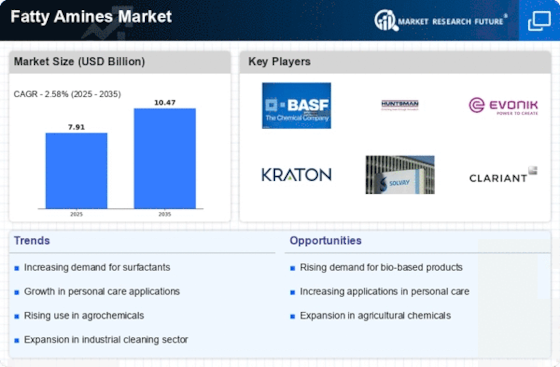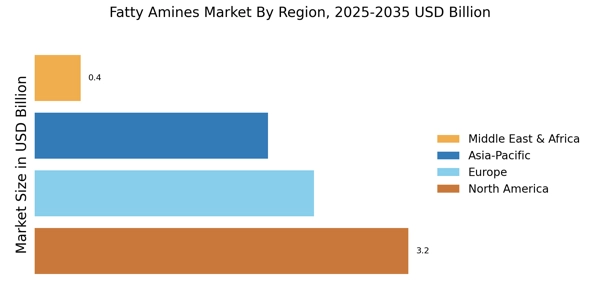Growth in Agricultural Applications
The Fatty Amines Market is significantly driven by the increasing application of fatty amines in agriculture, particularly as surfactants in pesticide formulations. These compounds enhance the efficacy of agrochemicals by improving their spreadability and adhesion on plant surfaces. The agricultural sector is witnessing a transformation, with a growing emphasis on sustainable practices and the use of bio-based products. The Fatty Amines is expected to reach USD 300 billion by 2025, which suggests a substantial opportunity for fatty amines to penetrate this sector. As farmers seek more effective and environmentally friendly solutions, the demand for fatty amines in agricultural applications is likely to escalate, thereby bolstering the Fatty Amines Market.
Rising Demand in Personal Care Products
The Fatty Amines Market experiences a notable surge in demand due to the increasing utilization of fatty amines in personal care products. These compounds serve as emulsifiers, surfactants, and conditioning agents, enhancing the texture and performance of cosmetics and skincare items. The market for personal care products is projected to grow at a compound annual growth rate of approximately 5.5%, which directly influences the fatty amines sector. As consumers become more conscious of product ingredients, the preference for bio-based and sustainable fatty amines is likely to rise, further propelling the Fatty Amines Market. This trend indicates a shift towards formulations that are not only effective but also environmentally friendly, thereby expanding the market's potential.
Emerging Markets and Economic Development
The Fatty Amines Market is poised for growth as emerging markets experience rapid economic development and urbanization. Countries in Asia and Africa are witnessing increased industrialization, leading to higher demand for fatty amines in various applications, including detergents, personal care, and agriculture. The urban population in these regions is expected to rise significantly, driving consumption patterns that favor fatty amines. As these markets develop, the need for effective and sustainable chemical solutions becomes paramount, suggesting a favorable environment for the Fatty Amines Market to thrive. This trend may lead to increased investments and innovations within the sector, further enhancing its growth prospects.
Increasing Use in Industrial Applications
The Fatty Amines Market is experiencing growth due to the rising demand for fatty amines in various industrial applications, including textiles, plastics, and rubber. These compounds are utilized as processing aids, stabilizers, and surfactants, contributing to improved product quality and performance. The textile industry, for instance, is projected to grow at a rate of 4.5% annually, which could lead to increased consumption of fatty amines. Additionally, the shift towards high-performance materials in the plastics and rubber sectors further supports the need for fatty amines. This trend indicates a robust potential for the Fatty Amines Market to expand its footprint across diverse industrial sectors.
Sustainability and Environmental Concerns
The Fatty Amines Market is increasingly influenced by sustainability and environmental concerns, as consumers and manufacturers alike prioritize eco-friendly products. The shift towards bio-based fatty amines, derived from renewable resources, is gaining traction as industries seek to reduce their carbon footprint. Regulatory frameworks are also evolving to support the use of sustainable chemicals, which may further drive the adoption of fatty amines. The market for bio-based chemicals is projected to grow significantly, indicating a potential shift in consumer preferences. This trend suggests that the Fatty Amines Market must adapt to these changing dynamics to remain competitive and relevant in an increasingly environmentally conscious marketplace.


















Leave a Comment